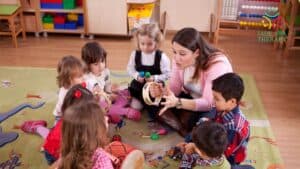Play is a vital part of childhood development. Through play, children learn social, emotional, communication, and cognitive skills that allow them to interact with others and the world around them. However, for children with autism spectrum disorder (ASD), play often looks much different than it does for neurotypical children.
In this comprehensive guide, we will explore the differences in how autistic kids play, the reasons behind these differences, and strategies parents can use to encourage more interactive play. With the right understanding and approaches, families can gain insight into their child’s unique needs and help them develop critical social and communication abilities through play.

The Challenges of Play for Children with Autism
For many parents, observing their autistic child engage in repetitive play rituals or shy away from interactive games can be worrying. Play is meant to be fun and social, so when an autistic child deviates from “normal” childhood play patterns, it can feel like something is wrong. However, these differences do not mean that autistic children don’t want to play or engage with others. Rather, the way they play is a reflection of the unique ways in which autism impacts development.
Some key differences in how autistic children play:
- Strong preference for solitary play
- Difficulty sharing toys or taking turns
- Repetitive, ritualized actions with toys (lining up, stacking, spinning, etc.)
- Minimal interest in pretend play or role playing
- May not respond to social overtures from others
- Prone to emotional outbursts if play rituals are interrupted
These differences can make playdates, family games, and even simple playtime challenging for autistic kids. But with understanding and a proactive approach, parents can turn play into an opportunity. Read on to learn why autistic children play differently, and how you can help them develop critical social communication skills through play.
Why Autistic Children Play Differently
Experts have identified three primary areas where autistic kids show differences from neurotypical children when it comes to play: imitation skills, symbolic/pretend play, and social communication. Understanding the root causes of these differences is key to supporting more creative, interactive play.
Imitation Differences
In neurotypical development, children observe others at play and naturally imitate what they see. This allows them to learn new play skills and games from peers. Autistic children show less natural imitation, meaning they are less likely to pick up on play cues from others.1
However, many autistic kids do display a form of imitation known as echolalia. This involves repeating words, phrases, or actions—often things they’ve heard on TV or from family members. Echolalia serves as a self-regulating stimming behavior rather than true social imitation.6 Kids may repeat certain words or phrases when excited or anxious. While this may seem like functional imitation, it is actually more akin to scripting.
Symbolic/Pretend Play Differences
Around age 3, most neurotypical kids engage in pretend play by pretending an object is something else (like using a box as a car), role playing with toys, or creating imaginary scenarios. This type of symbolic play allows children to be creative, practice social skills, and work through emotions.
Many autistic children show less interest in pretend play or have difficulty coming up with symbolic play ideas. Their play is more likely to focus on sensory experiences like spinning toy wheels or lining up blocks. Without explicit teaching, these kids are less likely to engage in the type of pretend play that builds so many skills.7
Social Communication Differences
Play provides neurotypical kids with constant opportunities to practice communicating with others. Whether turn-taking, assigning pretend roles, or sharing toys, play requires back-and-forth exchanges and attention between kids.
Autistic children often struggle to communicate socially during play. They have difficulty reading social cues, taking conversational turns, staying focused on shared activities, and connecting what they say to what others say.1 While they may want to engage with others, these social communication challenges get in the way.
By understanding why autistic children play differently in key developmental areas, parents can thoughtfully support improvements through play-based interventions. Turning play into a learning opportunity offers a way to work on core challenges in a fun, engaging, and developmentally-appropriate way.
Strategies to Encourage Interactive Play
Various therapeutic techniques use play as a way to improve social, communication, and developmental skills for autistic children. When thoughtfully incorporated into everyday life, these strategies can encourage more creative, interactive play while also addressing core skill deficits.
Floortime
This technique emphasizes following the child’s lead during play. The parent joins the child on the floor and builds on whatever interests them, creating back-and-forth exchanges to work on communication. No toys are needed—the focus is on the interaction.11
Relationship Development Intervention (RDI)
RDI uses play to build emotional sharing and engagement between parent and child. Play activities are designed to foster skills like referencing (communicating about a shared topic), social coordination, and emotional sharing.12
The PLAY Project
This autism intervention uses parent-led play sessions to build engagement and shared enjoyment. Parents structure sessions around the child’s interests and work on joining, imitating, supporting, and expanding their play.13
Other Tips:
- Set up play dates with patient friends willing to follow the child’s lead. Parallel play allows social interaction at the autistic child’s comfort level.
- Use toys to act out everyday activities and model communication. For example, have dolls “talk” to practice conversational turns.
- Assign pretend roles during play—let the child be the leader. Model role playing language and actions.
- Narrate your child’s play to model descriptive language. Refrain from asking too many questions.
- Expand play themes your child seems interested in. If they line up blocks, help build the line longer.
- Imitate your child’s play behaviors to validate their interests. This builds rapport for teaching new skills.
- Offer play choices between activities you know your child enjoys to build flexibility.
The most important thing is meeting your child where they are currently at with play. Validate their interests while gently introducing skills like turn-taking, role play, and verbal communication through the power of play.
The Benefits of Improving Play Skills
Play is not just for fun – it builds the foundation for social, emotional, and cognitive skills. By working on play deficits, families allow children with autism to gain benefits including:
- Improved language and communication skills
- Increased flexibility, problem solving, and creativity
- Better perspective taking and understanding of others
- Healthy self-regulation and coping strategies
- Higher self-esteem and sense of accomplishment
- Stronger bonds with family members and peers
Play is a natural context for improving many areas of challenge for autistic kids. Targeting differences through developmentally-appropriate play can have lifelong benefits that go far beyond having fun.
ABA Therapy: A Research-Based Approach for Autism Support
When looking for services to help address play skills and other autism-related challenges, applied behavior analysis (ABA) therapy offers a research-backed approach. This highly customizable therapy uses positive reinforcement to motivate learning and teach functional life skills to children with ASD.
Numerous studies show ABA can successfully improve communication, social skills, cognition, play, and more for autistic individuals.14 It does this by breaking larger goals down into small, teachable steps practiced through play, instruction, and real-life activities. Parent training is also a key component of ABA.
For families in Maryland looking for an experienced ABA therapy provider, Jade ABA Therapy offers top-quality, center-based and in-home services. Their passionate team of therapists, educators, and psychologists individualize ABA programs to meet each child’s unique needs. This allows them to target skill deficits like play through personalized, compassionate therapy.
Jade ABA Therapy’s individualized approach and unwavering support provides Maryland families with a trusted partner in helping their child reach their full potential. To learn more about their ABA services or schedule a risk-free assessment, contact them today.
The Takeaway
Play is a vital engine for developing key skills, making it important to address play challenges in autistic children. While autistic kids engage differently in play, parents can implement proven techniques to encourage more creative, interactive play. Using play to work on core deficits provides a developmentally-appropriate way to help children with autism improve communication, social skills, and flexibility.
By meeting children where they are and building up play skills through evidence-based therapies like ABA, families gain a powerful way to help their child thrive. If you have any concerns about your child’s play development, don’t hesitate to reach out to supportive professionals. With the right guidance, play can become an opportunity for learning, growth, and fun.
In-Home ABA in Maryland
Get started with world-class ABA therapy in Maryland that will help your child thrive. Our therapists provide outstanding service, and we’re confident we can help you and your child. Call us today at (410) 616-0901 or email us at info@jadeaba.org.
References:
- Maenner, M.J., Shaw, K.A., Baio, J., et al. (2020). Prevalence of autism spectrum disorder among children aged 8 years – autism and developmental disabilities monitoring network, 11 sites, United States, 2016. MMWR Surveillance Summaries, 69(4), 1-12. https://doi.org/10.15585/mmwr.ss6904a1
- Malhi, P., & Singhi, P. (2014). A retrospective study of toddlers with autism spectrum disorder: Clinical and developmental profile. Annals of Indian Academy of Neurology, 17(1), 25. https://doi.org/10.4103/0972-2327.128537
- Brownell, C. A., Iesue, S. S., Nichols, S. R., & Svetlova, M. (2013). Mine or yours? Development of sharing in toddlers in relation to ownership understanding. Child development, 84(3), 906-920. https://doi.org/10.1111/cdev.12009
- Mazefsky, C. A., Herrington, J., Siegel, M., Scarpa, A., Maddox, B. B., Scahill, L., & White, S. W. (2013). The role of emotion regulation in autism spectrum disorder. Journal of the American Academy of Child & Adolescent Psychiatry, 52(7), 679-688. https://doi.org/10.1016/j.jaac.2013.05.006
- Elbeltagi, R., Al-Beltagi, M., Saeed, N. K., & Alhawamdeh, R. (2022). Play therapy in children with autism: Its role, implications and limitations. World Journal of Clinical Pediatrics, 12(1), 21-32. https://doi.org/10.5409/wjcp.v12i1.21
- Van Santen, J. P., Sproat, R. W., & Hill, A. P. (2013). Quantifying repetitive speech in autism spectrum disorders and language impairment. Autism Research, 6(5), 372-383. https://doi.org/10.1002/aur.1301
- Kasari, C., Chang, Y. C., & Patterson, S. (2013). Pretending to play or playing to pretend: The case of autism. American Journal of Play, 6(1), 124-135.
- Davis, P. E., Slater, J., Marshall, D., & Robins, D. L. (2022). Autistic children who create imaginary companions: Evidence of social benefits. Autism, 27(1), 244-252. https://doi.org/10.1177/13623613221092195
- Berthier, M. L., Torres-Prioris, M. J., & López-Barroso, D. (2017). Thinking on treating echolalia in aphasia: Recommendations and caveats for future research directions. Frontiers in human neuroscience, 11, 164. https://doi.org/10.3389/fnhum.2017.00164
- National Institutes of Health. Joint attention therapy for autism. https://www.ncbi.nlm.nih.gov/books/NBK513399/
- Divya, K. Y., Begum, F., John, S. E., & Francis, F. (2022). DIR/floor time in engaging autism: A systematic review. Iranian journal of nursing and midwifery research, 27(2), 132. https://doi.org/10.4103/ijnmr.IJNMR_272_21
- Medavarapu, S., Marella, L. L., Sangem, A., & Kairam, R. (2019). Where is the evidence? A narrative literature review of the treatment modalities for autism spectrum disorders. Cureus, 11(1). https://doi.org/10.7759/cureus.3901
- The PLAY Project. About the PLAY project. https://www.theplayproject.com
- Peters-Scheffer, N., Didden, R., Korzilius, H., & Sturmey, P. (2011). A meta-analytic study on the effectiveness of comprehensive ABA-based early intervention programs for children with autism spectrum disorders. Research in Autism Spectrum Disorders, 5(1), 60-69. https://doi.org/10.1016/j.rasd.2010.03.011



